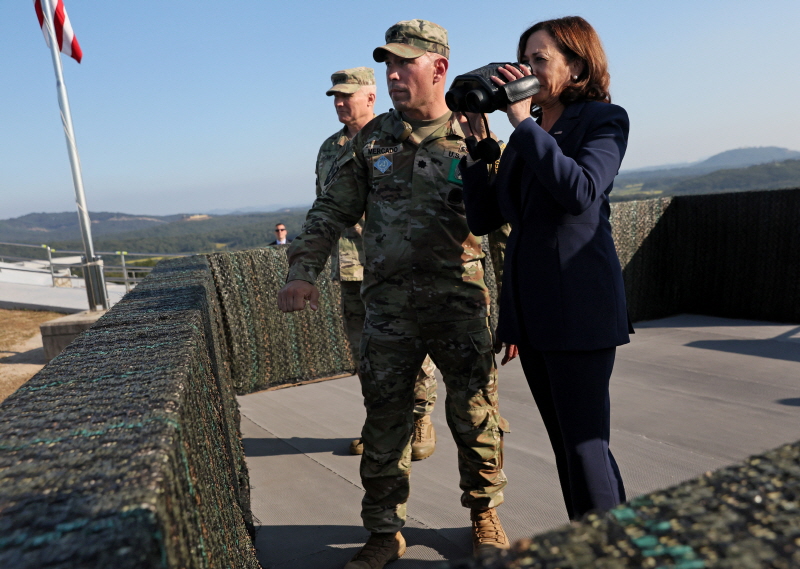Within less than 24 hours since former U.S. President Donald Trump, during a televised debate for the U.S. presidential election on September 10, stated, “Look at what’s going on with North Korea,” Pyongyang launched a short-range ballistic missile (SRBM) into the East Sea on September 12, local time.
In a related move, North Korea recently unveiled its uranium enrichment facility for the first time, signaling its intent to heighten its global presence ahead of the U.S. election. Experts suggest that North Korea could carry out nuclear tests and further missile launches to increase its influence during this crucial period.
[North Korea reveals uranium enrichment facility for the first time, vows to counter ‘U.S. threat’]
While North Korea had previously focused its efforts on recovering from devastating floods that hit the Pyongan and Jagang provinces in late July—limiting its provocations to low-intensity actions like the release of trash balloons—the abrupt SRBM launch appears to be influenced by the U.S. election debate.

During the debate, Democratic candidate Vice President Kamala Harris criticized Trump, stating, “Dictators and autocrats are rooting for you to be president again because they’re so clear, they can manipulate you with flattery and favors.”
In response, Trump cited Hungarian Prime Minister Viktor Orban, claiming, “China and North Korea fear Trump,” and added, “Look at what’s going on with North Korea, by the way.”
Trump contrasted his presidency, when North Korea maintained a moratorium on nuclear and long-range missile tests, with the Biden administration, during which North Korea resumed missile provocations in March 2022.
This latest missile launch is viewed as North Korea’s effort to assert its presence and influence ahead of the U.S. election, which is less than 50 days away. According to a CNN poll conducted after the debate, 63% of voters believed Harris performed better than Trump, suggesting that North Korea’s actions may be aimed at preventing Trump from losing ground in the tight race.
Kim Jae-chun, a professor at Sogang University’s Graduate School of International Studies, noted that although the chances are slim, Kim Jong-un may hold out hope that a re-elected Trump would engage in disarmament talks.
“Trump, who is open to one-off deals and personal connections with dictators, may be seen as a more favorable negotiating partner for Kim than Harris,” he explained. “As the U.S. election approaches, we may see further attempts by North Korea to draw attention to itself.”

Despite this, North Korea chose to launch an SRBM rather than more provocative weapons like an intercontinental ballistic missile (ICBM) or military reconnaissance satellite. Analysts suggest that North Korea’s focus on flood recovery has limited its ability to carry out larger-scale provocations, making the SRBM launch a simpler and lower-risk option.
The South Korean government is closely monitoring the possibility of further provocations by North Korea, including a potential seventh nuclear test, which has been prepared since early 2022.
Foreign Minister Cho Tae-yul, in a parliamentary session on September 10, mentioned that many experts believe North Korea could stage a major provocation to draw attention ahead of the U.S. election.
Meanwhile, North Korea’s Punggye-ri nuclear test site has reportedly suffered flood damage, including the destruction of nearby bridges, according to U.S.-based North Korea monitoring group 38 North. While this type of damage is a regular occurrence at Punggye-ri, some analysts suggest that the extent of the damage could impact the timing of a potential nuclear test.

Furthermore, intelligence sources indicate that North Korea’s military factories in Jagang Province have also been severely affected by the recent floods.
The South Korean military suspects that North Korea’s missile launch may have involved a super-large multiple rocket launcher (KN-25).
A senior South Korean presidential office official stated, “The large rocket launched today can be classified as a short-range missile, and it may be a message of continued threat against us. There’s also speculation that it could be a test model intended for export to Russia, as part of their ongoing military exchanges.”
BY HYUNJU PARK, YOUNGNAM KIM [park.hyunju@joongang.co.kr]


![Column: An Era When Green Card Interviews End in Handcuffs (Left) Tae-ha Hwang and wife Xelena Diaz at the USCIS Los Angeles office, where Hwang was detained mid-interview. (Right) The marriage certificate submitted for Hwang’s marriage-based residency petition. The photo has been blurred for privacy reasons. [Courtesy of Xelena Diaz]](https://www.koreadailyus.com/wp-content/uploads/2025/12/1208-newsletter-Hwang-100x70.jpg)

